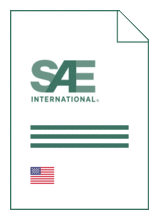
Standard [CURRENT]
SAE AMS 3279D:2013-03-12
Sealing Compound, Sprayable, for Integral Fuel Tanks and Fuel Cell Cavities, For Intermittent Use to 350°F (177°C)
- Publication date
- 2013-03-12
- Original language
- English
- Pages
- 19
- Publication date
- 2013-03-12
- Original language
- English
- Pages
- 19
Product information on this site:
Quick delivery via download or delivery service
Buy securely with a credit card or pay upon receipt of invoice
All transactions are encrypted
Short description
This document has been declared "Stabilized" and will no longer be subjected to periodic reviews for currency. Users are responsible for verifying references and continued suitability or technical requirements. New technology may exist. This specification covers one type of sprayable fuel resistant polythioether urethane sealing compound supplied as a two-component system. This sealing compound has been used typically for sealing metal and composite integral fuel tanks by spray application, but usage is not limited to such applications. It can be used for original fuel tank sealing of seams, joints, fasteners and fay surface edges or for repair of conventional fillet and fastener seals. As a fuel containment barrier, it can also be used on the interior or exterior of auxiliary fuel tanks and fuel cell cavities. It can be cured at ambient temperatures or with mild heat up to 140 °F (60 °C) following an initial 4 to 5 hour ambient cure period after each coating application. A primer, specifiedby the sealant manufacturer, is required with the sealing compound and must be applied prior to sealing. The sealingcompound can be applied in fuel tank and non-fuel tank areas by the use of a spray gun. Sealant can be applied by brush for small touch-up areas. The sealing compound is usable long term from -65 to 250 °F (-54 to + 121 °C), with short term exposure (approximately 6 hours) to 350 °F (171 °C).
Loading recommended items...
Loading recommended items...
Loading recommended items...

